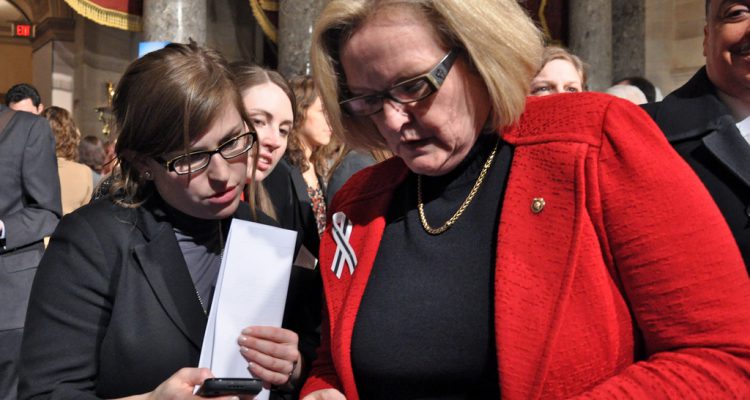By: Patrick W. Zimmerman
In the Senate, the Center could not hold.
While the outgoing class of House Republicans has an almost random distribution to its ideological spread, the Senate does pretty much conform to the narrative that moderates on both sides of the aisle were at particular risk. Whether or not this is a good thing will depend quite a bit on where your particular flavor of ideal democratic model falls on the pro- or anti-establishment spectrum, but it’s a remarkable feature that confirms, at least at the level of the upper chamber of Congress, media and analyst narratives about our current elevated levels of political polarization, tribalism, and partisanship.
So, the next questions are:
- How does that effect the behavior of the Senate?
- Is this the new normal, is polarization still increasing, or will it subside over time?
The short-short version
Discounting Al Franken (who left for non-electoral reasons, the only outgoing Senator who was more extreme ideologically than his party’s average was Jeff Flake. The other 6 outgoing senators were an average of 1.01σ more moderate than the average ideological score (DW-nominate) of their party’s members up for election in 2018. Important Note: Because of the way the Senate rotates classes, we’re going to mostly focus on the subset of Senators who just stood for election (Class 1), as opposed to the 2/3 of the Senate whose positions were not judged by their constituents.
The Republicans who left in 2018 for political reasons had an average DW-nominate score of: +0.524. Without Flake, that drops to +0.414. The rest of the Class 1 Republicans: +0.485 (Mississippi’s Thad Cochran retired in April due to health concerns. His replacement, Cindy Hyde-Smith, won reelection and is taken into account in this dataset).
The Democrats who left in 2018 for political reasons had an average DW-nominate score of: -0.195 (-0.144 taking out Franken, who left in January in a scandal unrelated to the election) The rest of the Class 1 Democrats: -0.340 (including Franken’s replacement, Tina Smith, who was reelected).
Results
Looking both at DW-nominate and position (a metric we’ve created that is calculated using the z-score of their DW-nominate rating compared to the average of their party’s Class 1 members and is the color-coded number to the far right), both outgoing Republicans and Democrats tended to be from their party’s moderate wings. That is to say, their DW-nominate scores were closer to 0, Republican positions were negative, and Democratic positions were positive. Only Flake really bucks the trend (as Franken barely counts, since his removal was not really related to the election).
Mouseover for details.
Looking at Class 1 Democrats’ performance last month, it’s probably more interesting to focus on the moderate Democrats/Independents who didn’t get the axe. 3 of the 4 most moderate Democrats lost, and 4 of the top 7. Joe Manchin in West Virginia and Angus King in Maine probably can be chalked up to the somewhat unique political inertia of their states, but what’s so special about Thomas Carper of Delaware? Geography, maybe (the Mid-Atlantic as a whole was not exactly enamored with the Republican Party, Trump in particular).
Mouseover for details.
Of Class 1 Republicans, Flake was the only real conservative that lost, and he might be a special case, considering how early he announced his pending retirement (more than a year ahead of time, in October 2017), in addition to the political effect of the (relatively) more moderate John McCain’s cancer diagnosis and (eventual) death. By the time of the mideterms, Arizonans had known for a year that they would likely be considering candidates for not one, but two, Senatorial positions within a short amount of time. Apart from that, every outgoing Republican was to the left of the party center (though Dean Heller of Nevada just barely). Which relatively moderate republicans survived? The two Mississippians.
Mouseover for details.
So, what now?
Given the highly partisan nature of the last Senate, it’s hardly surprising that neither votes on healthcare, tax cuts, nor Brett Kavanaugh’s confirmation were significant in any way to the pattern of winners and losers in the 2018 senatorial elections. The Senate has, with a few notable exceptions possibly driven as much by personal animosity as policy squabbles, voted pretty tightly along party lines for the entirety of the 115th Congress.
Guess what? It’ll probably get worse over the next two years, unless El Presidente does something so outlandish that he drives some members of the GOP’s more moderate wing to decide that his support of their legislative agenda is not worth the potential political fallout of association with him. The thing is, that moderate wing just got a little smaller, and most of the Democrats most likely to reach across the aisle on things like infrastructure, defense spending, and so on also just got shown the door.
Regarding the medium-term question of whether or not this kind of politics is the new normal, or whether or not everything will be back to civil political discourse once the catalyst for rudeness (Trump) exits the White House, our gut is that things will stay this way for awhile. Tribalism in American politics has been exacerbated by Trump, but it predated him (see: Garland, Merrick, among many other examples), and, thus, it is logical to hypothesize that it will outlast his administration, as well. While it’s debatable as to whether or not #theresistance should ratchet down the belligerence, we see no particular evidence that they’re likely to do so any time soon. Opposition to a perceived (or real) existential threat has borne quite a bit of fruit: new blood in the Democratic Party leadership, turnout numbers for a midterm nearly unheard of, a reeling Republican Party. Why, from a tactical perspective, would they change?

No Comments on "The Center could not hold: Outgoing Senators take the moderate wings of both parties out the door"